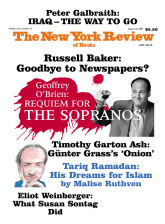In response to:
The Other Einstein from the June 14, 2007 issue
To the Editors:
I very much enjoyed Lee Smolin’s recent article on Einstein [“The Other Einstein,” NYR, June 14]. Let me however comment on something at the end concerning Einstein and the quantum theory. Rivers of ink have flowed on this and it still arouses great interest—even passion. Smolin writes, “As for Einstein’s dissent from quantum mechanics, there remains the stubborn fact that a significant fraction of those who have thought the matter through find themselves in agreement with Einstein that quantum mechanics must be understood as an incomplete approximation to a very different theory.” I have no idea which of my colleagues would be included in the “significant fraction” but I would need to know to what they are agreeing. If they are agreeing that quantum mechanics may eventually be replaced by another theory that includes it, then I would join them. If they are agreeing to Einstein’s stated reasons then I would say not only have they not “thought the matter through,” but they have not read enough Einstein.
Einstein in the course of his life had several different views about the quantum theory but his final view—you can read about it most clearly in his communications with Max Born—was that the theory does not give a complete description of properties of objects that have what Einstein referred to as a “real existence.” The position and momentum of a particle being an example. In the Einstein, Podolsky, and Rosen thought experiment cited in Smolin’s article it is alleged that measurements can be performed that confer a simultaneous value to these quantities, which is a violation of the Heisenberg uncertainty principle. Hence you cannot both believe in quantum mechanics and that a determination of these quantities, which Einstein would say have a “real existence,” can be made. In fact, a quantum mechanician like Bohr would say that, in the absence of an experiment to determine them, these quantities have no existence at all. This is what Einstein objected to. He once walked back from the Institute for Advanced Study in Princeton with the late Abraham Pais. The moon was out and Einstein asked Pais, “Do you really believe the moon is not there when you are not looking at it?”
The EPR paper came out in 1935 and for at least two decades no one paid much attention to it. However, in 1964, the late John Bell published a paper that changed everything. He showed that Einstein’s idea that the results of quantum mechanics could be reproduced by a theory in which Einstein’s notions of realism were included could be tested in the laboratory. Having spent a good deal of time talking to Bell I can tell you that his heart was with Einstein. He often referred to Bohr as an “obscurantist.” But the experiments were carried out by Alain Aspect and others and showed that Einstein was wrong and Bohr was right. I cannot believe that anyone familiar with this would still agree with Einstein.
Jeremy Bernstein
Aspen, Colorado
Lee Smolin replies:
I have been all my life a great fan of Jeremy Bernstein’s writings but he incorrectly interprets the assumptions of Bell’s theorem and the related experiments. Bell’s result depended on two assumptions: Einstein’s notion of the “real existence” of the properties of objects, plus the assumption that physical effects are local. According to this second assumption, what is real at one place cannot be influenced by the setting of a switch on an experiment at another place. Quantum mechanics violates this notion of locality because a single system can split into two systems whose properties remain entangled even when they travel apart from each other.
The experimental disproof of Bell’s result requires that at least one of these assumptions is wrong. Some of us are happy to hypothesize that it is the assumption that physical effects are local that is wrong. This assumption can be denied while holding fully to Einstein’s notion of realism. We know this because there are theories that make the same predictions as quantum mechanics and are fully consistent with Einstein’s notion of realism, but give up the assumption of locality. Two examples are the pilot wave theory of Louis de Broglie and David Bohm and the theory of spontaneous wave-function collapse of Ghirardi, Rimini, and Weber.
Theories such as these, which give a realistic description of quantum phenomena, are called hidden variables theories. According to such theories, quantum mechanics is statistical because it gives an incomplete description of reality. Alain Aspect’s experiment only ruled out hidden variables theories that are local; but there are non-local theories of hidden variables such as the ones I mentioned by de Broglie and Bohm, and by Ghirardi, Rimini, and Weber.
Indeed, some recent work in quantum gravity suggests that locality—the assumption that physical effects are local—is only an approximate concept that emerges during the early universe from a more fundamental level of reality without space or locality. If this is true, then there is no barrier to the possibility that quantum mechanics will be supplanted by a more fundamental theory which satisfies Einstein’s notion of realism.
Advertisement
This Issue
August 16, 2007



